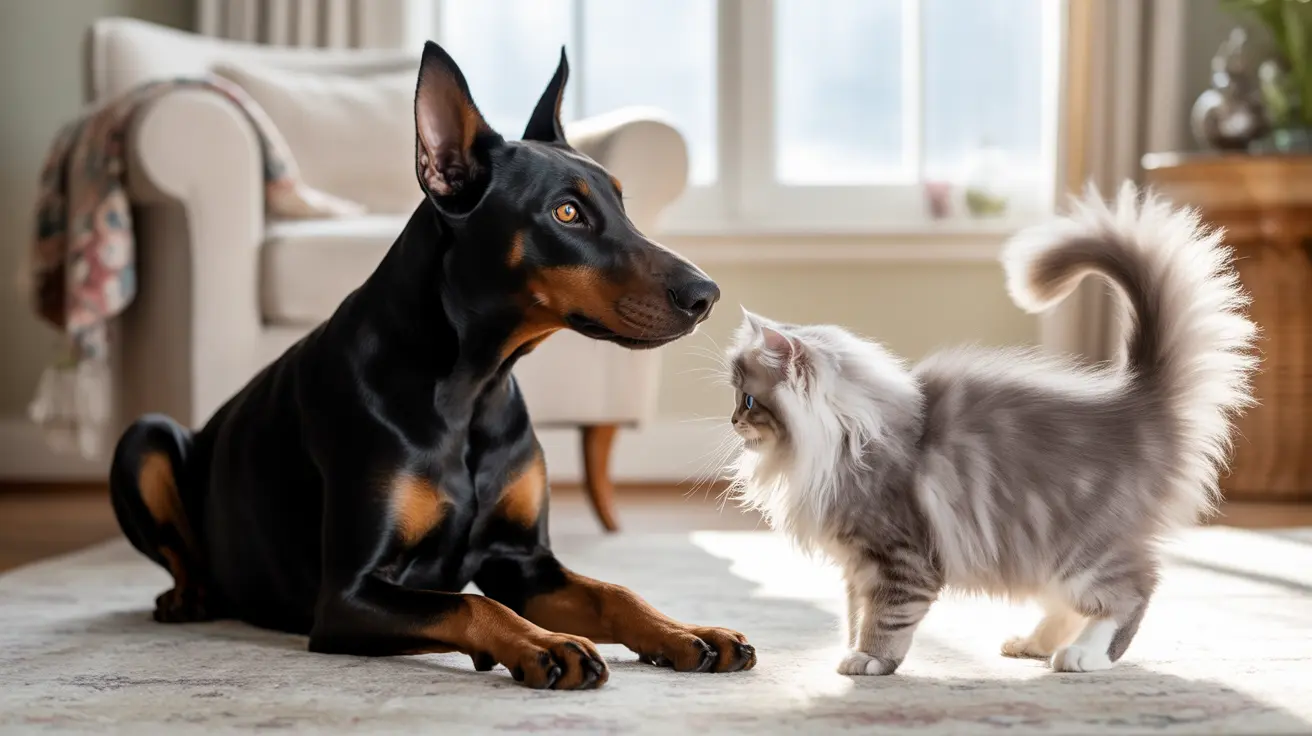Understanding Doberman Temperament
Dobermans are known for their intelligence, loyalty, and protective nature. These traits, combined with their high energy levels and natural prey drive, can influence their interactions with cats. However, contrary to common misconceptions, many Dobermans can learn to be gentle and respectful toward feline family members.
Statistics from DobermanPlanet reveal encouraging numbers: approximately 75% of Doberman owners report successful coexistence between their dogs and cats, with 28% describing the relationship as "very well" and 47% as "okay."
Factors Affecting Doberman-Cat Relationships
Early Socialization
The age at which a Doberman is introduced to cats plays a crucial role in their future relationships. Puppies exposed to cats during their critical socialization period (between 3-16 weeks) are more likely to accept them as family members rather than prey.
Individual Personality
Each Doberman has a unique personality that affects their ability to live with cats. Some are naturally gentle and patient, while others may require more extensive training to control their prey drive and excitement around smaller animals.
Creating a Safe Environment
Physical Setup
A successful multi-pet household requires thoughtful environmental modifications:
- Designated cat-only spaces with high perches
- Baby gates to create safe zones
- Multiple litter boxes in cat-accessible areas
- Separate feeding areas for both pets
Training and Management
Consistent training is essential for teaching your Doberman appropriate behavior around cats:
- Basic obedience commands like "leave it" and "stay"
- Positive reinforcement for calm behavior
- Supervised interactions until trust is established
- Regular exercise to manage energy levels
Introduction Process
A carefully planned introduction process significantly increases the chances of success:
- Start with scent exchange using bedding or toys
- Allow visual contact through a barrier
- Supervise short, controlled meetings
- Gradually increase interaction time
- Maintain constant supervision until fully confident
Warning Signs and Risk Management
Watch for these potential red flags:
- Intense fixation on the cat
- Stalking or chasing behavior
- Inability to calm down around the cat
- Signs of stress from either animal
Frequently Asked Questions
Are Dobermans naturally inclined to chase or harm cats due to their prey drive?
While Dobermans do have a natural prey drive, it can be managed through proper training and socialization. Individual temperament varies, and many Dobermans learn to control their instincts around cats, especially when introduced early.
How can I safely introduce a Doberman puppy to a resident cat in my home?
Start with separate spaces, use baby gates for visual contact, and gradually allow supervised interactions. Always reward calm behavior and ensure the cat has escape routes. The process should take weeks to months, depending on both animals' comfort levels.
What are the best training techniques to help my Doberman get along with a cat?
Focus on positive reinforcement, teaching commands like "leave it" and "gentle," and rewarding calm behavior around cats. Consistent training, combined with proper exercise and mental stimulation, helps manage the Doberman's energy levels and prey drive.
Can adult Dobermans that have never lived with cats learn to coexist peacefully with them?
Yes, adult Dobermans can learn to live with cats, though it may require more time and patience compared to puppies. Success depends on the dog's individual temperament and the owner's commitment to training and management.
What safety measures should I take to prevent injuries during Doberman and cat interactions?
Always supervise interactions, provide escape routes for the cat, maintain separate spaces when unsupervised, and never force interactions. Ensure the cat has high places to retreat and consider using baby gates to create safe zones.
Conclusion
While Dobermans and cats can successfully live together, success requires commitment, proper training, and careful management. With patience, consistent training, and appropriate safety measures, many Dobermans can learn to become gentle companions to their feline family members. Remember that each situation is unique, and some pairs may need more time and training than others to achieve harmony.






